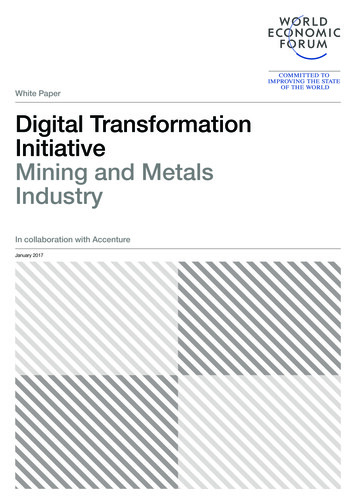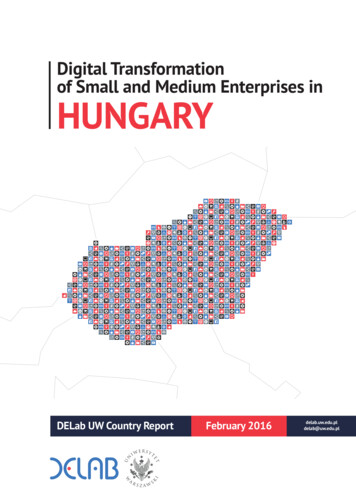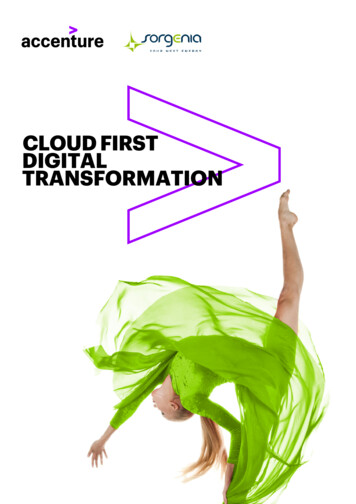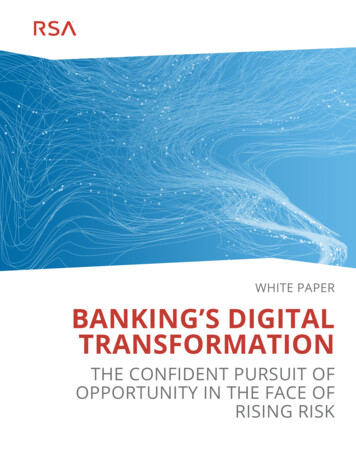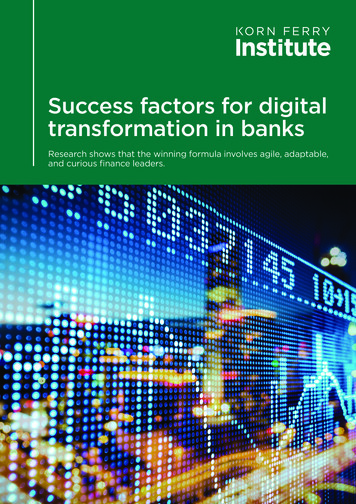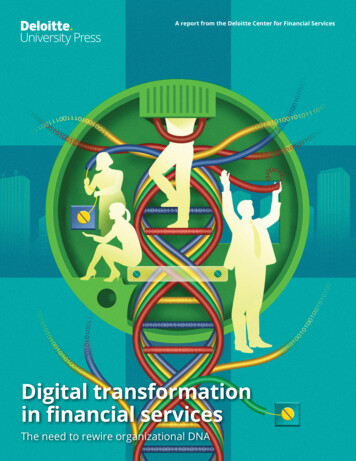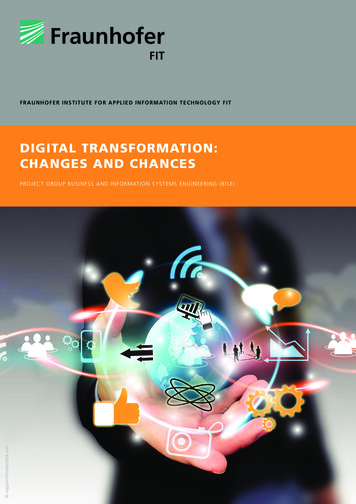
Transcription
FRA UNHO F ER I NSTIT U T E F OR A P P L IE D IN F ORM ATION TECH N OLOG Y FITDIGITAL TRANSFORMATION:CHANGES AND CHANCES nopporn/Shutterstock.comPR OJEC T GROU P BU S I N E S S A ND I N FO R M AT I O N S YSTEM S EN G I N EERI N G (BI SE)1
DIGITAL TRANSFORMATIONC HANGES AN D C H A N C E S –I NSI GHTS B A S E D ON A N E M P IR IC A L S TU D YProf. Dr. Henner GimpelProf. Dr. Maximilian RöglingerProf. Dr. Gimpel belongs to the Project Group BISE of theProf. Dr. Röglinger belongs to the Project Group BISE ofFraunhofer FIT, holds the professorship of Managementthe Fraunhofer FIT, heads the professorship of Business andEngineering in the Faculty of Mathematics, Natural SciencesInformation Systems Engineering and Value-based Businessand Materials Engineering at the University of Augsburg and isProcess Management at the University of Bayreuth and isdeputy director of the Research Center Finance & Informationdeputy director of the Research Center Finance & InformationManagement. His research interests are in digital transforma-Management. Most of his work centers on digital transfor-tion, customer orientation, innovation management, and themation, business process management, customer relationshipfuture of work. Professor Gimpel’s teaching centers aroundmanagement, and strategic IT management.business administration, information systems, sustainablemanagement, and service science.Contact:Prof. Dr. Henner GimpelProf. Dr. Maximilian RöglingerProject Group BISE of Fraunhofer FITProject Group BISE of Fraunhofer FITResearch Center FIMResearch Center FIMUniversity of AugsburgUniversity of BayreuthPhone 49 821 598-4818Phone 49 921 oeglinger@fit.fraunhofer.deThe use of the study findings is limited to internal purposes only. Please refrain from forwarding or publishing the study withoutapproval by Fraunhofer Institute for Applied Information Technology FIT.All icons applied remain property of the respective institutions.Recommended Citation:Gimpel, H. and Röglinger, M. 2015. Digital Transformation:Changes and Chances – Insights based on an Empirical Study.Project Group Business and Information Systems Engineering(BISE) of the Fraunhofer Institute for Applied Information Technology FIT, Augsburg/Bayreuth2
D I G I TA L T R A N S F O R M AT I O N :CHANGES AND CHANCESEx e cu tiv e S u m maryDigitalization impacts individuals, businesses, and society as a whole. In particular, the fastspread of digital technologies sets enormous change in motion. This implies huge challenges –and at the same time – promising chances for companies.The successful exploitation of such chances, however, requires many companies to transformappropriately. It is not that businesses need digitalization, but rather if they ignore it, they willbe left behind. This particularly concerns well-established companies that are not primarilystructured around or operating in the digital economy, and thus do not have native digitalstructures, yet whose future will depend on successful digital transformation.Therefore, this study is geared towards managers of well-established companies, presentingthem our perspective on the changes and chances associated with digital transformation. Basedon the empirical insights from interviews, workshops, and applied research projects, six actionfields are identified as relevant for successful digital transformation: Customer, Value Proposition, Operations, Data, Organizations, and Transformation Management. Each field is discussedin detail within this study. Furthermore, we propose a digital transformation self-assessmenttool, allowing companies to assess their individual need for action within each field based ontheir individual prioritization.3
CONTENTExecutive Summary31Digitalization Forces and Enables Companies to Transform522.12.22.32.42.52.62.7Digitalization Requires Mastering Six Fields of ActionOverview of the Six Fields of Action and the Self-Assessment ToolCustomerValue n Management991011121314163Management Tips for Digital Transformation174References185About Us194
1. DIGITALIZATION FORCES AND ENABLESCOMPANIES TO TRANSFORMDigital products and services have been embraced in the everyday life of individuals, businesses,and society as a whole. The impact of digitalization has been and still is tremendous, forcingcompanies across the globe to act and react to changing business rules. Today, more peoplehave access to cellphones than to toilets1 and one out of five people on the planet has an active Facebook account2. Needless to say, this phenomenon is associated with extensive changesamong companies, who face the question: What does digitalization mean to us? The answer is:a lot. This study provides a comprehensive and holistic overview to engender a successful digitaltransformation of a company by mastering six fields of action: Customer, Value Proposition,Operations, Data, Organizations, and Transformation Management.Digitalization:The increasing penetration ofFirst, digitalization disrupts established business rules both in the digital and the phys-digital technologies in societyical world. Some recent examples include: Uber, the world‘s largest taxi company that ownswith the associated changesno vehicles; Facebook, the world‘s most popular media owner that creates no content; Alibaba,in the connection of individu-the world‘s most valuable retailer that has no inventory; Airbnb, the world‘s largest accommo-als and their behaviors.dation provider that owns no real estate.Digital Transformation:These examples demonstrate the disruptive power of digitalization, which challenges estab-Managed adaptation of com-lished business rules and environments. For instance, the following becomes apparent: currentpanies in light of progress-business models must be reassessed, as they are likely to become outdated in the future digitaling digitalization in ordereconomy. Furthermore, traditional industry structures will erode or come under pressure. Onto assure sustainable valuethe one hand, digitalization promotes the winner-take-all effect and, on the other, it offerscreation.huge potential for new niche players and micro-businesses that challenge the position ofincumbents. Consequently, companies might have to “destroy” their own business modelsbefore others do and come up with digital innovations to thrive in the digital race. As thereare low entry barriers in many parts of the digital economy, new competitors are more likely to shape and conquer the market. Increasing competitive pressure arises especially frompowerful, digital native companies that continuously push forward in a variety of traditionalbusiness sectors. Another result is that digital activities largely impact the physical world interms of embedded systems, smart devices, and sensor networks. Such interdependencies canno longer be ignored. Moreover, digital technologies empower customers, e.g., through fastspreading word-of-mouth effects in social media. Thus, customer focus becomes ever morevaluable and mastering the end-user interface becomes critical for companies – and this islargely independent of where a company is in the digital value chain. The need for change isalso driven by changing employee behavior and thought patterns that require modern intra-organizational communication and interaction forms. Finally, although digitalization largelyaffects Business-to-Consumer (B2C) markets – companies should not lose sight of opportunitiesin Business-to-Business (B2B) markets such as adapting established digital B2C online marketingand sales practices. Overall, the collapse of some established companies confirms the peril ofignoring these changes as well as the need for transformation.5
Figure 1 More and moredigital technologies andservices are available 3These delineated changes are driven and enabled by a hugewidespread adoption of smart devices, such as smart phonesvariety of new digital technology that became available inand tablets, and mobile applications, the current digitalizationthe last few years (see Figure 1). Their rapid growth and com-wave has experienced an excessive boost. In fact, the newmoditization has increasingly pushed the speed and broad-aspect of digitalization is not the usage of informationened the impact of digitalization. For instance, today userstechnology per se but the speed of change and theadopt a new technology much more quickly than ever before:world’s level of connectedness. While formerly digitali-While it took 38 years for the radio to reach 50 million people,zation mainly concerned data management and processingthe iPod reached that number in only four years and Instagramwithin the IT department of companies, today it affects allwas adopted by that number of users in less than six monthsdepartments and has moved from administrative and support-(see Figure 2). The number of connected devices will rise to 25ive tasks to core business processes. The impacts range frombillion by 20204 and will, by far, exceed the world population.changes in marketing and sales processes, new collaborationThis brings with it an enormous economic potential across alland interaction patterns, to newly designed products and ser-industry sectors. Alone the Internet of Things (IoT), i.e., thevices. In the course of this, the interaction with the end-user,connection of anything physical with the Internet, has an esti-as well as their changed behaviors, becomes of particular, vitalmated economic potential of USD 1.9 trillion by 20205.importance. However, this is not the final focus. The digital economy is continuously progressing. The underlying driv-Digitalization is not an entirely new phenomenon: Data hasers of this phenomenon ever increasing its speed are “Moore’sbeen processed and exchanged digitally for more than half alaw” and “Metcalf’s law”: computing hardware becomes evercentury. Early examples include electronic data interchangemore powerful, small, and thus embedded and ubiquitous.(EDI) that started in the 1960s. The Internet has been usedSimultaneously, network effects lead to a superlinear increaseby the general population since the 1990s and e-commercein value by connecting systems, processes, and users.was first promoted around the year 2000. However, with the6
D I G I TA L T R A N S F O R M AT I O N :CHANGES AND CHANCESFigure 2 Digitalization is driven bythe rapid growth6 and commoditization of digital technologies7The digital economy will converge towards an ecosys-systems continuously co-evolve and in the course of this eventem of collectively intelligent cyber-physical and cy-transform each other. Thereby, the overarching goal of CHSber-human systems based on ever-increasing connectivityis to advance human capabilities – perceptive and cognitive,and technological opportunities (see Figure 3). As part of thisphysical and virtual, social and societal – through innova-evolution, the digital and the physical world are continuouslytive computational and informational capabilities. Whereas,merging: Cyber-physical systems (CPS) integrate compu-formerly, only IT had a supporting role by facilitating all kindstational and physical capabilities, where the physical compo-of processes without direct human contact, nowadays – innents may be mechanical or electronic; embedded systemsthe era of digitalization – IT and humans have moved closerand networks automatically monitor, communicate, and con-together and are collaborating nearly seamlessly. Thus, digitali-trol physical processes or systems. This cyber system could be,zation now shapes a system that is, at the same time, both thefor instance, an intelligent manufacturing line with automatedcause and the effect of its major characteristics: volatility (i.e.,production processes, where each work piece carries digitalconstant and massive changes), uncertainty (i.e., lack of pre-assembly information and exchanges this autonomously withdictability), complexity (i.e., multitude of interrelated, powerfulthe relevant machines such as via RFID-tags. The term CPS isactors building strong forces, difficult to control), and ambigu-often used synonymously with the IoT, which encompassesity (i.e., confounding cause and effect relationships) – in short,major technology enabling the connecting of physical entitiesa VUCA world.via the Internet. Cyber-human systems (CHS) refer to theincreasingly coupled relationships between humans and com-Thus, the progression of digitalization implies huge changesputing:8,9– but at the same time brings along promising opportunitiesin recent years, all kinds of computing technology,ranging from traditional computers, mobile devices, wear-for companies. However, many companies have to transformables, to person-embedded sensors, are constantly mergingappropriately to leverage these opportunities: it is not thatwith human lives. This development is fostered, for example,businesses need digitalization, but rather if they ignore it, theyby new communication patterns or varied and possibly mul-will be left behind. Thereby, the development of digital tech-tiple modalities such as innovative computer displays, haptic,nologies itself is not the business need necessarily, but ratheraudio, and brain-machine interfaces. Thus, cyber and humanthe challenge is how such technologies can be best used to7
St udy D es ignTo sharpen our understanding of digital transformation, weconducted semi-structured interviews and workshops, andincorporated experiences from applied research projectswith various industry partners. We approached B2C andB2B companies of various industries including automotive,engineering, chemicals, transportation and logistics, telecommunication, healthcare, and financial services. Overall,we conducted interviews and workshops with representatives of more than 50 companies. See Figure 4 for characteristics of the sample. We approached companies andasked to interview the
a lot. This study provides a comprehensive and holistic overview to engender a successful digital transformation of a company by mastering six fields of action: Customer, Value Proposition, Operations, Data, Organizations, and Transformation Management. First, digitalization disrupts established business rules both in the digital and the phys-



